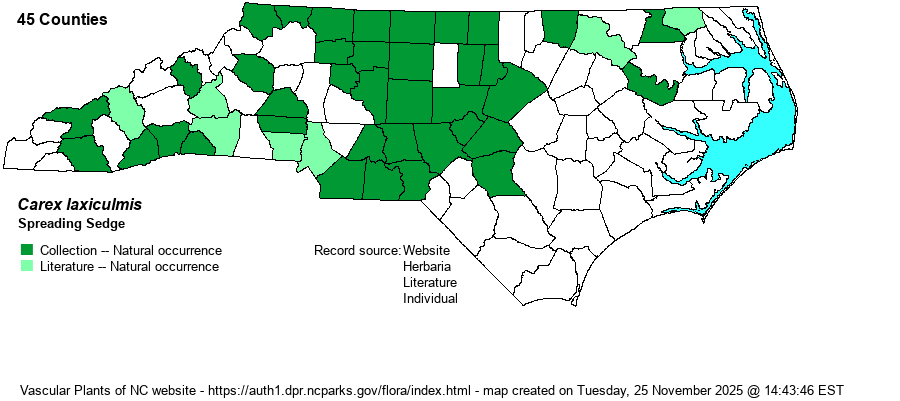| Section 5 » Order Cyperales » Family Cyperaceae |
Show/Hide Synonym
| taxonName | relationship | relatedTaxonName | relatedTaxonRefText | relComments |
|---|
| Carex laxiculmis | = | Carex laxiculmis var. laxiculmis | Flora of North America (1993b, 1997, 2000, 2002a, 2002b, 2003a, 2004b, 2005, 2006a, 2006b, 2006c, 2007a, 2009, 2010) | | | Carex laxiculmis | = | Carex laxiculmis var. laxiculmis | Kartesz (1999) | | | Carex laxiculmis | = | Carex laxiculmis var. laxiculmis | | | | Carex laxiculmis | = | Carex laxiculmis var. laxiculmis | | | | Carex laxiculmis | < | Carex laxiculmis | Gleason (1952) | | | Carex laxiculmis | < | Carex laxiculmis | Radford, Ahles, and Bell (1968) | | | Carex laxiculmis | < | Carex laxiculmis | Small (1933, 1938) | | | Carex laxiculmis | < | Carex laxiculmis | Wofford (1989) | | |
|
| Source: Weakley's Flora |
|
| Author | Schweinitz | |
| Distribution | Mostly Piedmont, and scattered in the Mountains; rare in the Coastal Plain, mainly along brownwater rivers there.
ME to WI and IA south to northwestern GA and MO. | |
| Abundance | Frequent to common in the Piedmont, uncommon to scarce elsewhere -- Mountains and upper/middle Coastal Plain along a few brownwater rivers (Meherrin, Roanoke, and Cape Fear). The website editors suggest a State Rank of S4, as the NCNHP's rank of S3 is clearly too conservative. | |
| Habitat | Mesic to moist hardwoods and pine-hardwood forests, upper terraces of floodplains and bottomlands. Tolerates fairly acidic to alkaline soils, but usually where moist (though by no means restricted to wetlands). | |
| Phenology | Flowering and fruiting April-June. | |
| Identification | Plants of Spreading Sedge are glaucescent to glaucous. The perigynia are strongly 3-sided; and the lowermost spike is on a long, arching stalk. Leaves are much wider than its near-relative C. digitalis, and the latter is not glaucescent. Spreading Sedge normally has much shorter stems and leaves than members of the Laxiflorae section (C. laxiflora, C. blanda, C. crebriflora, C. striatula, etc.). In NC, the very closely related Carex copulata occurs only(?) in the Mountains and has green rather than glaucous leaves. | |
| Taxonomic Comments | FNA recognizes C. laxiculmis var. copulata; however, Weakley recognizes that taxon as a full species -- C. copulata, which see. More specimens and habitat data are desired.
The genus Carex is the largest in North America, and among the largest in the world. In temperate and boreal regions, Carex is often the dominant or co-dominant ground layer in many habitats. Seeds (achenes) are valuable food for birds and small mammals, while foliage is used by birds and mammals to make nests and as food by mammals. Species of Carex often look vastly different from one another -- spikes erect vs. drooping, tiny inflorescence vs. whopping, culms leafy vs. naked, perigynia beaked vs. beakless, stems densely bunched vs. single, etc. The genus has been divided into many sections (or groups), based on shared characters; some taxonomists have suggested that these be different genera, but that proves unworkable (so far). All Carex share the feature of a perigynium (an outer covering) which completely surrounds the achene (seed). This covering may fit tightly or loosely (like a small bladder), depending on which group or species. Details of perigynia shape, ornamentation, presence and size of beak, number of striations (or veins) are all important ID features. In recent years Rob Naczi and colleagues have stressed the importance of arrangement of perigynia -- whether spiral (3+ ranks) or distichous (2-ranked) -- and have named a number of new species as well as split off some older synonyms. Therefore, RAB's (1968) key, excellent for its time, can only be used in a general way today. Members of some sections of Carex are difficult to key out (notably Ovales, Laxiflorae, Griseae); this is in part due to variation among individuals of a species, or failings of the key. FNA has drawings of most species and some species may be found in two or more places within a key, to acount for variability. New species to NC, and new to science(!), continue to be found in NC. | |
| Other Common Name(s) | None | |
| State Rank | S3 [S4] | |
| Global Rank | G5 | |
| State Status | | |
| US Status | | |
| USACE-agcp | | |
| USACE-emp | | |

